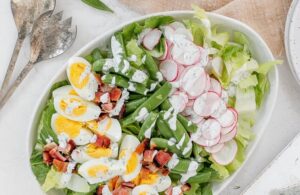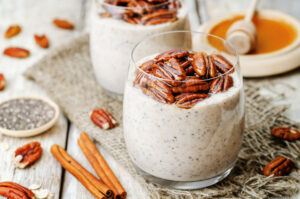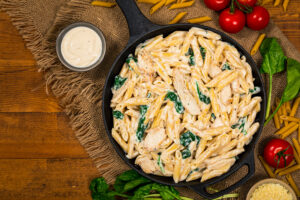Prep: 20 mins Total: 20 mins
This Spring Cobb Salad is a fresh, seasonal twist on a classic favorite—perfect for a light yet satisfying meal. Crisp Romaine forms the base, layered with vibrant spring vegetables like thinly sliced radishes and sweet snap peas for a burst of color and crunch. Protein-rich hard-boiled eggs and savory chopped bacon add heartiness, while a creamy Greek yogurt dill dressing ties it all together with a tangy, herbaceous flavor.

Why You’ll Love This Recipe
- Quick & Easy: Ready in just 20 minutes, it’s perfect for busy days or spontaneous meals.
- Seasonal & Bright: Showcases Spring produce like snap peas and radishes for a light, seasonal flavor.
- Make-Ahead Friendly: Stays fresh for up to three days—just add the dressing when you’re ready to enjoy.
Ingredients
- 4 Eggs
- 1/3 cup Plain Greek Yogurt
- 1 Tbsp Lemon Juice
- 2 Tbsps Fresh Dill (chopped)
- 2 Tbsps Water
- Sea Salt & Black Pepper (to taste)
- 5 leaves Romaine (chopped)
- 1/3 cup Radishes (thinly sliced)
- 1 cup Snap Peas (trimmed)
- 4 slices Bacon, Cooked (chopped)
Directions
- Place the eggs in a saucepan and cover with water. Cover and bring to a boil. Once boiling, turn off the heat and let it sit for 12 minutes. Drain and run cold water over the eggs until cool enough to handle and peel. Quarter and set aside.
- Meanwhile, combine the yogurt, lemon juice, dill, water, salt, and pepper in a small bowl or jar. Whisk or shake the jar until well combined.
- In a large salad bowl, add the Romaine, radishes, peas, and cooked bacon. Add the dressing and toss to combine. Add the eggs and toss gently to incorporate. Divide evenly between plates and enjoy!
Nutritional Information
- Serving Size: 2 1/2 cups of salad, 2 eggs
- Calories: 294
- Fat: 18g
- Saturated Fat: 6g
- Carbohydrate: 10g
- Fiber: 3g
- Sugar: 4g
- Sodium: 537mg
- Protein: 24g





